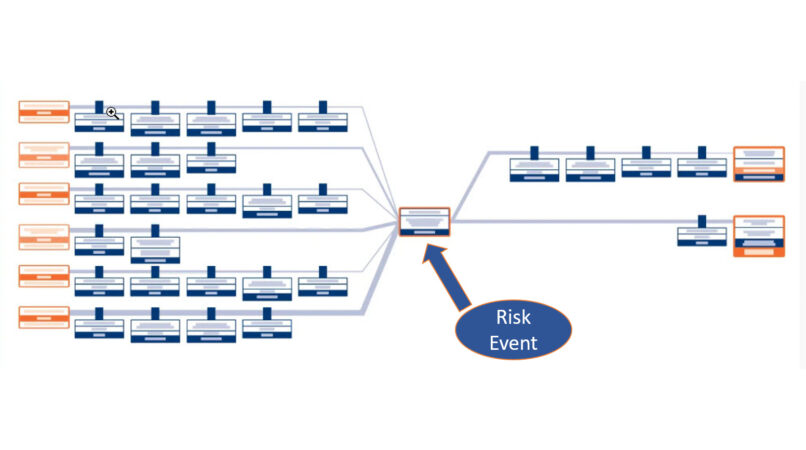Many EHS professionals know they struggle with managing workplace risks, whether it’s accurately assessing them, controlling them, or getting the entire workplace involved in the process. In our new series, “The Bowtie Analysis Blog,” we’ll tell you about how a risk assessment tool called bowtie analysis can help.
In this first installment, we’ll talk about how bowties can help you with a common pain point: training your workers about workplace risks and the controls you have in place, and actually keeping them engaged in your risk management practices. We’ll also debunk the misconception that bowtie analysis is an esoteric, difficult tool to use, and explain how it can help you and your workers stay on top of changes to your risks even as your workplace and operations evolve.
A Comprehensive View of Risk
Imagine for a minute that all the knowledge of your workplace risks is saved in different formats, in different places. You have spreadsheets and documents, you have checklists, and you have historical records of various kinds of risk assessments, like hazard studies. Now add to that treasure trove, the knowledge held in the heads of everyone from engineering, operations, maintenance, purchasing, etc.. In fact, you probably don’t need to imagine that, because it’s probably your situation right now, the same as it is for most EHS professionals.
But now, imagine that you can put that information together in a way that provides a comprehensive view of your workplace risks, at a glance—one that lets you map the connections between causes of every type of safety incident to its potential consequences, and show what controls are in place to mitigate harm. That’s what a bowtie analysis does, and that’s what makes it so useful.
Here’s what it looks like:

As you can see above, a bowtie pulls together all of the relevant information about possible accidents into one place, where it’s easier to review and comprehend. Rather than have to hunt through multiple documents and types of assessments and then try to assemble the big picture, bowtie analysis creates the big picture for you. By using bowties, we and our workforce can easily understand:
- the linkages between risk causes and the risk event, and between the risk event and subsequent risk impacts.
- a common understanding of how systems/processes work and their propensity to fail.
- what risk controls are in place.
- how those controls act to reduce risk, and why they are only as effective as the person/process verifying they will work when expected.
But Aren’t Bowties Really Hard to Build?
Not anymore, at least not if you have the right tools.
It definitely used to be hard to do bowtie analysis, because much of the work had to be done either manually or using standard desktop computer applications to do things they were not specifically to do. And the information needed to make them was in so many different places, with no method available to easily unify the information or even to share it across different systems. That’s why many EHS professionals still mistakenly believe that bowties are just too hard to build and use—that they’re tools for someone else, not them.
The great thing about VelocityEHS’s Risk Management platform is that it democratizes the approach to risk by making it easy for all companies and all EHS professionals to perform bowtie analysis. In fact, it’s as simple as hitting a button. Just select “Generate Bowtie” while in the software, then watch as it pulls information from your hazard studies and other risk assessments, analyzes it, maps tabular data into a bowtie, and displays the results.
Bowties Improve Worker Safety Engagement
In fact, when you make bowtie analysis easy, you also make it easy for all your workers at all levels to understand risks, and you make it easier for them to participate in the process. That helps you get the insights of those who know risks better than anyone—the people who work with those processes every day.
Direct participation by workers in safety management yields obvious benefit, which is why an emerging consensus of global safety experts, as represented by standards like ISO 45001, sees that participation as being essential to a successful safety management system. Section 5.4 of 45001 on Consultation and Participation of Workers says, “The organization shall establish, implement and maintain a process(es) for consultation and participation of workers at all applicable levels and functions,” and specifically emphasizes the need for participation of non-managerial workers in “identifying hazards and assessing risks and opportunities.”
In the past, the fractured nature of risk data and the difficulty of creating bowties made it harder than it should have been to actively involve employees in the process. But when you use VelocityEHS Risk Management to make the process easy, you boost engagement in several ways:
Improved Understanding: Employees can only participate in risk management if they understand risks, and bowties make that much easier. The visual organization of the bowtie helps all employees understand the connections between procedures, policies, control devices and risk reduction.
Motivating Safer Work Practices: Because employees can clearly see how unplanned events and potential consequences extend outwards from various causes, it motivates them to more consciously avoid behaviors and workplace practices that can set such an event into motion. They’ll understand the reasons behind workplace safety policies and safe operating procedures (SOPs) and be more likely to model safe behavior.
Integrating Workers into a Single, Simple Process: One overarching method for mapping and demonstrating risks makes it easier for employees to participate in the process than the old fragmented approaches. Employees can directly participate via “what if” scenario brainstorming and easily adjusting the bowtie to incorporate their own knowledge of operations and controls. This in turn improves the overall risk management process by harnessing the collective knowledge of the entire workforce.
The Perfect Training Tool for an Ever-Changing Workplace
All of the features of bowties we’ve been discussing make them the perfect training tool. We can give employees an easy-to-use “map” of workplace risks that doesn’t require them to hunt through multiple documents for the information they need, helps them understand how the controls interact to prevent and mitigate risks, underscores the purpose of carrying out the repetitive inspections and observations required to verify control effectiveness, and ultimately reinforces the value and purpose of our risk management practices in keeping us all safe. This improves the effectiveness of our employee training, and also gives us an easy way to keep employees well-trained on current practices even as our operations change.
This latter point is an important one. Workplaces and the nature of work itself continue to evolve, due to changing technology, changing work arrangements, and changes necessitated by business or production goals. The ongoing COVID-19 pandemic accelerated trends already recognized by initiatives like National Institute of Occupational Safety and Health (NIOSH) “Future of Work,” forcing organizations to make quick pivots such as workplace reorganizations to protect employees from exposure to the SARS CoV-2 virus. In some cases, organizations may have added new production lines for products such as hand sanitizer in public demand during the pandemic. All such change modifies the landscape of risks in the workplace, and quickly can cause our risk assessments and risk management plans to become out of date.
But with the simplicity of bowtie analysis you get with VelocityEHS Risk Management, you’ll be easily able to adjust your bowties or generate new ones as operations change. Even better, you can involve your employees in the process, and keep them well aware of all the components of your current risk management system.
It’s the simple way to effectively train your workers on workplace risks and maintain their awareness level, no matter what the future of work may hold.
For more information about risk bowties, be sure to check out the second installment of this Bowtie Analysis Blog series
Let VelocityEHS Help!
Our customers consistently report that our Bowtie Analysis solution has helped them achieve dramatic improvements to workplace productivity, knowledge sharing and risk management program performance.
And bowtie analysis is just one of many tools within our Risk Management platform, along with risk registers, qualitative and quantitative risk analysis, layers of protection analysis (LOPA), critical controls verification and much more!
Ready to see more? Visit our Risk Management page to learn more, and to request a demo with one of our customer solutions consultants today!
